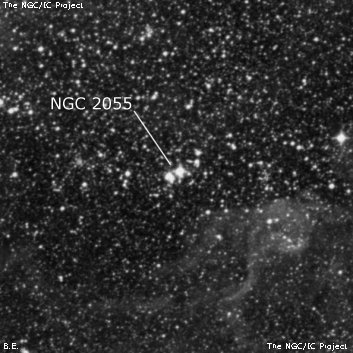
Within this cloud is S-L 610 (often misidentified as NGC 2055), a small knot of four stars in a 1' region. It includes two bright "stars" (R127, V ≈ 10.5 and R128, V ≈ 10.7 ) at 20" separation, along with two 12th mag stars to the northwest. Both R127 and R128 are very compact clusters with R127 containing the brightest Luminous Blue Variable (LBV) in the LMC! NGC 2050 is probably a group of stars on the north side of the cloud. Roughly ~20 stars were resolved including a mag 10.6 star at the west edge and a mag 10.7 star (11" double) at the southwest edge. The central part contains several mag 12 stars and HD 38030, a mag 13.0 Wolf-Rayet (Brey 68).
A long stream of mag 10-12 stars begins about 12' W of the cluster and extends east-northeast for over 20', including NGC 2050 and association LH 97 at the NE corner of the large star cloud, and passing just south of the Tarantula Nebula.
John Herschel discovered NGC 2055 = h2931 on 24 Nov 1834 and noted "a vL v rich cluster of sc st 10...15 which more than fills the field." His position is near the center of this large association or star cloud (LH 96), which includes NGC 2050 and S-L 610.
300/350mm - 14" (4/4/16 - Coonabarabran, 145x): roughly 120 stars are resolved in a gorgeous 15'x10' SW-NE star cloud (association LH 96) situated to the south of the Tarantula Nebula. The cloud is rich in faint stars but also includes a mag 9.6 star (HD 269820) at the southwest edge, along with a few other mag 10.5 stars. The background shows unresolved haze and perhaps nebulosity. Adding an NPB filter, there is definite nebulosity in the northeastern quadrant of the cloud. It spreads northwest and northeast, merging with the outer tendrils of the Tarantula Nebula!
Notes by Steve Gottlieb